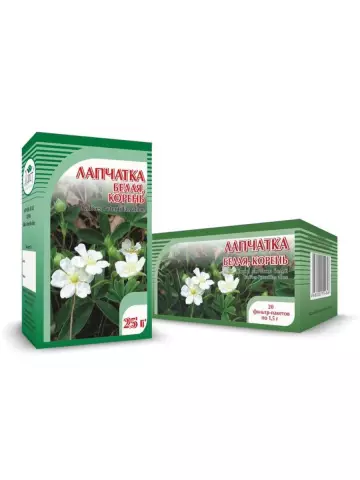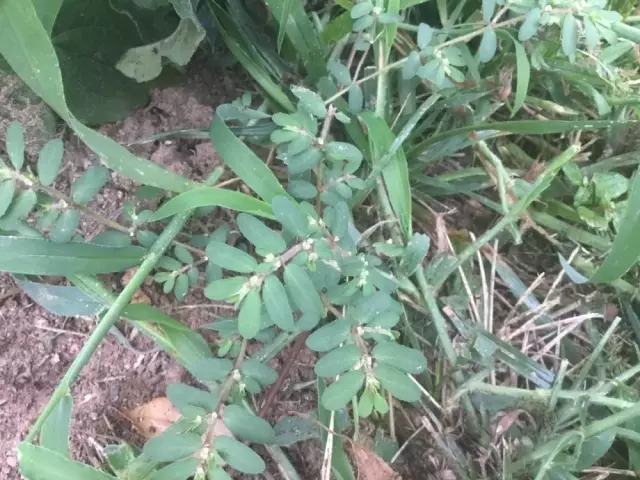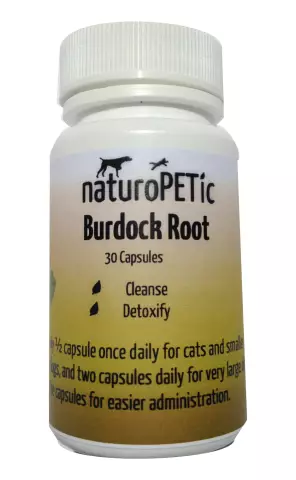- Author Rachel Wainwright [email protected].
- Public 2023-12-15 07:39.
- Last modified 2025-11-02 20:14.
Bloodroot
Instructions for use:
- 1. Pharmacological action
- 2. Release form
- 3. Indications for use
- 4. Contraindications
- 5. Instructions for use
- 6. Side effects
- 7. Storage conditions
Prices in online pharmacies:
from 123 rub.
Buy

Cinquefoil is a herbal medicine with anti-inflammatory, tonic, antimicrobial and hemostatic action, widely used in traditional and folk medicine.
pharmachologic effect
Cinquefoil belongs to one of the largest in terms of the number of plant genera (family Pink).
Basically, the genus consists of perennials, but there are annuals, biennials and shrubs. The genus got its name from the Latin word potents, which means strong or powerful, since the healing properties of many members of the genus have long been used in medicine.
The most common and well-known are White Cinquefoil, Goose Cinquefoil, Shrub Cinquefoil and Erect Cinquefoil.
White cinquefoil is a perennial herb with a thick, scaly rhizome and thin short stems. It grows mainly in Europe, preferring light woods, meadows and grassy slopes. White cinquefoil has been used in folk medicine since the 18th century for the treatment of the thyroid gland, dysentery, liver diseases of the gastrointestinal tract and the cardiovascular system. Topically used to treat carbuncles, boils, abscesses, abscesses, using the antiseptic and wound-healing properties of the plant.
Cinquefoil goose is a perennial low herb. Other names - Goose foot, Caterpillar or cramp grass.
The rhizome of Cinquefoil goose is unbranched, thick, scaly, with a high protein and starch content.
It is used as a medicinal plant, usually using leaves that contain organic acids, tannins, flavonoids and fatty oil. A decoction and infusion of Cinquefoil goose has a hemostatic, anticonvulsant, astringent, antiseptic and diuretic effect. Cinquefoil goose is used for the treatment of inflammatory diseases of the mouth and throat, as well as for skin lesions - cuts, burns and various inflammations. It is part of the homeopathic remedy Potentilla anserina.
Shrub cinquefoil is a highly branched shrub. Other names - Kuril tea or Shrub Pentafolum. Shrub cinquefoil grows mainly in mountainous areas on moist, drained soils. It is widely used in Mongolian and Indo-Tibetan medicine as a decoction for gastrointestinal diseases. Due to the large number of biologically active compounds, cinquefoil is used as an anti-inflammatory, hemostatic and soothing agent.
Erect cinquefoil is a perennial plant with low erect stems. Another name is Kalgan wild or Kalgan-grass.
Cinquefoil rhizome and root - woody, cylindrical, unevenly thickened, short and contains a large number of biologically active compounds: tannins, flavonoids, essential oil, tormentillin glycoside, red pigment flobafen, tormentol ether, quinic and ellagic acids, flobaphenes, gum, wax, resins, starch and sugars. Cinquefoil is used as a spice, as a raw material for making paint and as a hemostatic, astringent, tonic, anti-burn, bactericidal and anti-inflammatory agent in traditional and folk medicine.
Also, the cinquefoil root reduces capillary permeability, has a vasoconstrictor effect and protects tissue from bacterial, chemical and mechanical effects.
Release form
Cinquefoil is produced in the form of crushed plant materials in cardboard boxes of 50 g, 75 g, 100 g and vegetable powder in filter bags of 2.5 g.
Also, the root of Cinquefoil is included in various teas and teas.
Indications for the use of Cinquefoil
Cinquefoil is used for:
- Gastritis;
- Tonsillitis;
- Dysentery;
- Cholangitis;
- Jade;
- Colpite;
- Hepatitis and cirrhosis of the liver, including ascites;
- Enterocolitis;
- Eczema;
- Bleeding gums;
- Skin cracks and burns;
- Stomatitis;
- Pharyngitis;
- Gingivitis;
- Enteritis;
- Diarrhea;
- Ulcerative colitis;
- Peptic ulcer of the stomach and duodenum;
- Cholecystitis;
- Hemorrhoids
- Gout and rheumatism;
- Bleeding of various etymologies;
- Vaginitis and cervical erosion;
- Atopic dermatitis and diffuse neurodermatitis.
Contraindications
Cinquefoil root is contraindicated only in case of individual plant intolerance.
Instructions for use of Cinquefoil

Cinquefoil is used both internally and externally.
Cinquefoil is used internally in the form of an infusion or decoction 3-4 times a day. A decoction or infusion is usually taken in 30 ml, tinctures - 25-30 drops. With cirrhosis of the liver, Cinquefoil is used in the form of an infusion three times a day, 40-100 ml 2 hours before meals. The course of treatment is long, up to two months. As a prophylaxis, you can use Cinquefoil in the form of a decoction or infusion twice a year in the autumn-spring period for a month.
Outwardly, Cinquefoil is used for douching, rinsing the mouth, wet dressings, lotions and applications, using a decoction or infusion.
To heal burns and deep cracks, 1 tablespoon of crushed cinquefoil root is boiled in one glass of unsalted butter for 10-15 minutes, after which it is filtered while still warm.
Side effects
Cinquefoil rarely causes side effects in the form of allergic reactions.
Storage conditions
Cinquefoil root can be purchased over the counter without a prescription. Shelf life is 3 years.
Cinquefoil: prices in online pharmacies
|
Drug name Price Pharmacy |
|
Cinquefoil white root crushed roots 20 g 1 pc. 123 r Buy |
|
White cinquefoil plus coated tablets 100 pcs. RUB 200 Buy |
|
Cinquefoil white raw vegetable shredded 60 g 1 pc. 358 RUB Buy |
Information about the drug is generalized, provided for informational purposes only and does not replace the official instructions. Self-medication is hazardous to health!






